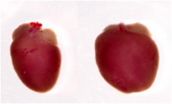(Press-News.org) Physicists, led by a researcher at the University of Warwick, studying new images of clouds of material exploding from the Sun have spotted instabilities forming in that exploding cloud that are similar to those seen in clouds in Earth's atmosphere.
These results could greatly assist physicists trying to understand and predict our Solar System's "weather".
The researchers, led by of the Centre for Fusion Space and Astrophysics, at the University of Warwick's Department of Physics, made their discovery when examining new images of clouds of material exploding from the Sun known as coronal mass ejections (CMEs). These images were provided by the Atmospheric Imaging Assembly (AIA) experiment on NASA's Solar Dynamics Observatory (SDO). SDO was been launched last year and provides unprecedented views of the Sun in multiple temperatures.
The new SDO/AIA observations provided images of coronal mass ejections in the extreme ultra violet at a temperature that was not possible to observe in previous instruments – 11 million Kelvin. On examining these images the Warwick researchers spotted a familiar pattern of instability on one flank of an exploding cloud of solar material that closely paralleled instabilities seen in Earth's clouds and waves on the surfaces of seas.
When observed these Kelvin-Helmholtz (or KH) instabilities appear to roll up into growing whirls at boundaries between things moving at different speeds, for instance the transition between air and water or cloud. The difference in speeds produces the boundary instabilities.
Similar conditions can occur when one looks at the magnetic environment of the path of these coronal mass ejections as they travel through the solar corona. The difference in speed and energies between the two creates the very similar KH instabilities that we can observe in clouds.
While KH instabilities have been predicted or inferred from observations as happening within the solar system's weather this is the very first time they have been directly observed in the corona. What makes this observation even more interesting is that the instabilities appear to form and build on one flank of the CME. This may explain why CMEs appear to bend and twist as these instabilities build, and cause drag, on one side of the cloud. This effect will be the next focus for the University of Warwick led research team.
University of Warwick researcher Dr Claire Foullon said:
"The fact that we now know that these KH instabilities in CMEs are so far only observable in the extreme ultra violet, at a temperature of 11 million Kelvin, will also help us in modelling CME behaviour"
"This new observation may give us a novel insight into why these CMEs appear to both rotate, and be deflected away from following a simple straight path from the surface of the Sun. If the instabilities form on just one flank they may increase drag one side of the CME causing it to move slower than the rest of the CME."
INFORMATION:
Dr Foullon and her co-researchers have outlined their observations and detailed modelling of how they believe this phenomenon occurs in a paper just published in Astrophysical Journal Letters entitled Magnetic Kelvin-Helmholtz Instability at the Sun by Dr Claire Foullon, Erwin Verwichte, Valery M. Nakariakov Centre for Fusion, Space and Astrophysics, Department of Physics, University of Warwick; Katariina Nykyri, Department of Physical Sciences, Embry-Riddle Aeronautical University, Daytona Beach, Florida; and Charles J. Farrugia, Space Science Center and Department of Physics, University of New Hampshire, Durham, New Hampshire.
The preprint is available at:
http://www.warwick.ac.uk/go/foullon/publications/foullon_preprint_apjl_2011.pdf
For further information please contact:
Dr Claire Foullon
Centre for Fusion, Space and Astrophysics,
Department of Physics,
University of Warwick,
Tel: +44(0)2476 150211
Claire.Foullon@warwick.ac.uk
Peter Dunn, Head of Communications, University of Warwick,
Tel: +44 24 (0)76 523708 Mobile/Cell +44 (0)7767 655860
p.j.dunn@warwick.ac.uk
New images show cloud exploding from Sun ripples like clouds on Earth
2011-02-05
ELSE PRESS RELEASES FROM THIS DATE:
Sugar boost for Oxfordshire scientists who are planning ahead for future medicines
2011-02-05
Scientists continuing to investigate a 50 year mystery have discovered another vital clue that could help pave the way for improved medicines. The results feature in a special edition of Nature celebrating the International Year of Chemistry. The findings reveal an important insight into the way carbohydrates (sugars) bond and this will influence the way drugs are designed in the future.
Using specialist laser equipment from the EPSRC-funded Laser Loan Pool managed by STFC's Central Laser Facility, Professors John Simons and Ben Davis together with co-workers from the ...
Tipping points -- the future of the pharmaceutical industry
2011-02-05
This declining trend is blamed on a failure of innovative drive in the industry, failure of the UK to support basic research, failure of venture capital to invest in early stage research, or failure of the Health Service to provide smart procurement.
A research centre funded by the Economic and Social Research Council (ESRC) shows that radical reform of the drugs industry regulatory system must be an important part of the solution to ensure a productive and profitable pharmaceutical sector, both globally and in the UK.
Researchers from the ESRC's Innogen centre have ...
Massive Daphnia genome leads to understanding gene-environment interactions
2011-02-05
DURHAM, N.H. – From an environmental perspective, Daphnia pulex -- the waterflea – is the best-studied organism on the planet. Scientists know how this species responds to pollution, predators, day and night, making it an important model for ecological and evolutionary research. Its genome, however, remained elusive, limiting understanding of how the environment and genes interact.
Until now. An international team of researchers comprising the Daphnia Genomics Consortium, including four from the University of New Hampshire's Hubbard Center for Genome Studies, has described ...
Emergency detection systems for senior citizens
2011-02-05
Ms. K. is vision-impaired and can't get around very well any more. Still, the 80-year-old, who lives alone, has no intention whatsoever of moving to a retirement home. Most elderly people think the same way. They want to stay in their accustomed surroundings as long as possible, where they can lead an autonomous life. What many fail to realize is that they are risking their health in the process. Cardiovascular problems are more frequent among the elderly, and the risk of falling is more prevalent: one person in three above the age of 65 falls once a year; among those over ...
Recipe for family mealtimes calls for 3 ingredients in the right amounts
2011-02-05
URBANA – A University of Illinois scientist reports that family mealtimes that contain three ingredients in the right amounts can improve the quality of life in children who have chronic asthma.
"Family mealtimes, when they're done right, are linked to many benefits for children, including a reduced risk of substance abuse, eating disorders, and obesity. In this study, we've put these mealtimes under a microscope so we can see minute by minute which factors deliver these healthy outcomes," said Barbara H. Fiese, director of the U of I's Family Resiliency Center.
Which ...
Improving care for bowel cancer patients
2011-02-05
Rainer Kube and his working group report in the current issue of Deutsches Ärzteblatt International (Dtsch Arztebl Int 2011; 108[4]: 41-6) on new treatment strategies in patients with colon cancer.
The findings of multicenter observational studies are a good basis for improvements to overall quality of patient care. Against this background, from 2000 to 2004 Kube and his coauthors collected data on over 31 000 patients in 346 German hospitals. From this data pool they extracted statements about the quality of care. They discovered, for example, that colonoscopy screening ...
Unemployment: A health risk
2011-02-05
Compared to people in employment, men and women who are unemployed suffer more often and longer from both physical and emotional complaints. Why the un-employed should have health problems more often is discussed by Lars E. Kroll and his coauthor in the current issue of Deutsches Ärzteblatt International (Dtsch Arztebl Int 2011; 4: 47-52), along with a report on the findings of the GEDA study.
The GEDA study (Gesundheit in Deutschland Aktuell, or Current Health in Germany) was carried out in 2008-2009 by the Robert Koch Institute. The results showed that unemployed people ...
Just in time for Valentine's Day: UNC researchers identify a gene critical for heart function
2011-02-05
CHAPEL HILL, N.C. – Everyone knows chocolate is critical to a happy Valentine's Day. Now scientists are one step closer to knowing what makes a heart happy the rest of the year.
It's a gene called DOT1L, and if you don't have enough of the DOT1L enzyme, you could be at risk for some types of heart disease. These findings from a study led by researchers at the University of North Carolina at Chapel Hill School of Medicine appear in the Feb. 1, 2011 issue of the journal Genes and Development.
The team created a special line of mice that were genetically predisposed to ...
First stars in universe were not alone
2011-02-05
The first stars in the universe were not as solitary as previously thought. In fact, they could have formed alongside numerous companions when the gas disks that surrounded them broke up during formation, giving birth to sibling stars in the fragments. These are the findings of studies performed with the aid of computer simulations by researchers at Heidelberg University's Centre for Astronomy together with colleagues at the Max Planck Institute for Astrophysics in Garching and the University of Texas at Austin (USA). The group's findings, published in Science Express, ...
Smithsonian scientists discover 7 new species of fish
2011-02-05
Things are not always what they seem when it comes to fish—something scientists at the Smithsonian Institution and the Ocean Science Foundation are finding out. Using modern genetic analysis, combined with traditional examination of morphology, the scientists discovered that what were once thought to be three species of blenny in the genus Starksia are actually 10 distinct species. The team's findings are published in the scientific journal ZooKeys, Feb. 3.
Starksia blennies, small (less than 2 inches) fish with elongated bodies, generally native to shallow to moderately ...



